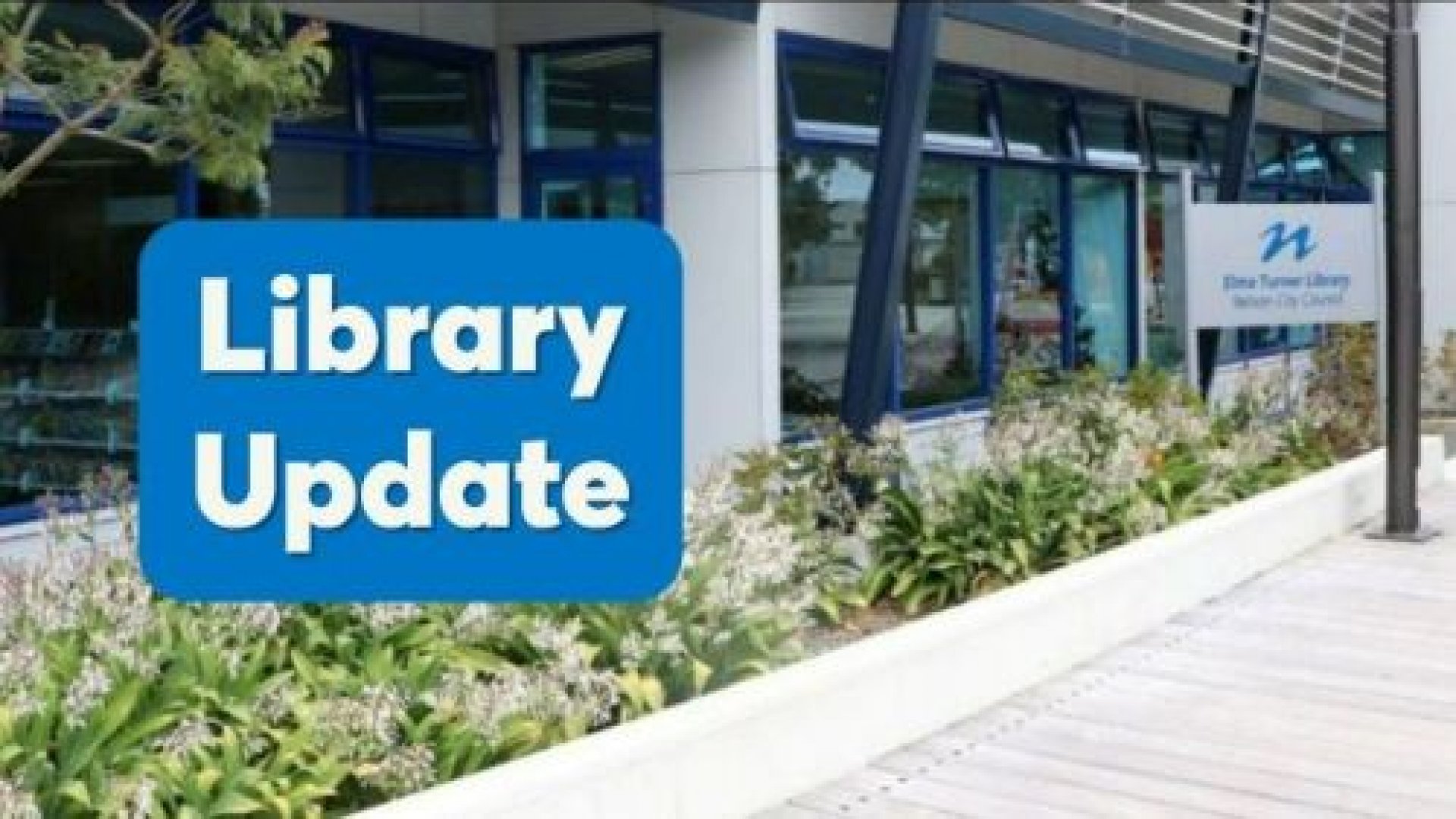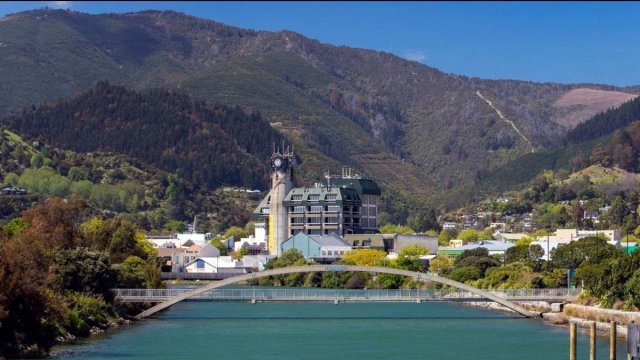Damaged roof trusses add costs and delay to Elma Turner Library reopening, further section opening planned
07/06/2023 3:46pm
New structural damage found in the roof trusses of Elma Turner Library during the process of earthquake strengthening has delayed its full reopening.
A partial reopening, including the main entrance and another large section of library floorspace, will take place on 26 July. This will mean that 70% of the total public area of the library will be returned to public use and represents a doubling of the area currently available to the public.
But the full reopening has been delayed after Nelson City Council contractors found damage to four trusses in the oldest public section of the library – the south side next to Halifax Street. The further strengthening work that is now necessary will take an estimated seven months to complete with the full library to reopen in February 2024.
A request for a further $940,000 to repair the additional damage will be made to Council on 6 July. If approved, this will bring the total cost of the Elma Turner Library earthquake strengthening project to $2.7 million.
Nelson Mayor Nick Smith, who leads the Library Reopening Taskforce, says the discovery of the damaged roof trusses at the southern end of the library is disappointing as it has set back the full reopening by seven months and added $940,000 to the cost when the project was previously on schedule and on budget.
“These scope increases are not uncommon when trying to patch up an older building. I am pleased the problem has been found as these are structural safety issues that need to be addressed immediately. The origin of this problem dates back to when the loading on the trusses was doubled with the addition of heated ceiling tiles and skylights in 1989, resulting in them being overloaded. The new work involves installing 17 steel columns, with concrete foundations and steel beams between them, in this oldest public section of the library to underpin and address the under-capacity of the trusses. Finding this flaw with the trusses has also resolved the question of the cause of roof leaks that now enables a more comprehensive fix of that issue.”
New section of Elma Turner Library to reopen in July
Library staff are focusing on reopening another large section of floor space, the library’s main entrance, and research room and main public toilets to the public on Wednesday 26 July.
The library will close for just over a week following the school holidays (17-25 July) to allow a considerable amount of the collection to be moved back to the public area – a further 25,000 books, five times the amount currently on the library floor. Stoke Library and Nightingale Library Memorial will open additional hours over the time Elma Turner Library is closed.
To restore access to the main bathroom block, situated at the edge of the closed area, a purpose-built, enclosed corridor will be constructed.
Nelson City Council Chief Executive Nigel Philpott says this will be the fourth change to the library space in just over a year for staff, who are looking forward to a library that more closely resembles the original area.
“We’ve gone from complete closure to a small, successful pop up, to a larger space and now we are getting back most of the library space and amenities that we know our community has been missing.
“I would like to thank the library staff and the community for their patience and understanding throughout this process. Library staff have gone above and beyond, working in disrupted conditions for about a year now and continue to do a fantastic job providing top-level service. We know the library is a valuable resource for many and I can assure you we are working diligently to ensure that it is fully operational as soon as possible.”
The newly reopened space will see the return of the study area, the lounges, the charging docks, access to the Research and Heritage Room, more public computers and additional seating.
Mayor Nick says once the full repairs are complete, the library will meet earthquake standard requirements of 67% New Building Standard (NBS) for the ceilings, and 34% NBS for the structure.
“This finding does not change the merits of extending the life of the current library. Spending $2.7 million fixing the problems with the tiles, structural connections and now the trusses will give us a safe library at an affordable cost while we explore and develop plans for a long-term replacement facility.”
FAQ
What new damage was found in the library and where is it?
Nelson City Council contractors found a split in one of the trusses supporting the roof in the oldest public section of the building, on the south side next to Halifax Street, on 30 April, 2023 when the ceiling tiles and insulation were removed in preparation for strengthening. See area in blue on the map below.
All work was immediately stopped, and props were installed to support the trusses as a precaution. Further investigations revealed buckling and splits in four trusses. The damaged trusses have affected the roofline resulting in sagging of the roof, preventing rain from running off efficiently and water pooling in some areas.
The library is made up of several areas of connected structures, built at different times over the years. The damage found is in the oldest part of the public area and is limited to the part of the building constructed in the 1985 extension while the building was used as a car sales yard.
All other public areas of the library have since been re-checked for structural damage as a precaution. Nothing further was found. 


Do you know what caused the damage and how long it has been there?
We believe the damage was caused by a combination of structural changes to the building, for example the addition of skylights in the roof and the change in ceiling tiles, and what are called ‘loading events’ where extra load is placed on the roof from earthquakes, high winds, and heavy rain.
While it is impossible to know with certainty when the damage occurred, the lack of dust or discoloration on the truss splits point towards the damage being more recent. However, we do note that insulation surrounded these trusses, so they have been in a protected environment.
In 1995, six split and buckled trusses were found and repaired. The newly discovered damage affects four trusses, including some of those already carrying damage from 1995. Repairs were carried out, and it was thought at the time the cause of the problem had been addressed.
While these events date back over 30 years, we believe it’s important to understand what occurred. We have commissioned Beca to review the initial conversion of the space and the repairs made in 1995 so any building, management and regulation lessons can be learnt.
What is the proposed fix?
To repair and strengthen the damaged area, new structural beams will be added to the split trusses, along with a series of steel posts within the library space to reduce the span of the trusses. The posts throughout the library space will enable the sagging trusses to be lifted back into a position close to originally designed, allowing water to flow from the roof properly once again. A stormwater piping system will be installed in the roof cavity to divert rainwater away from the roof eliminating any ponding, and the roof in this area will be reclad.

How much will the additional repairs cost?
The total cost for the additional repairs is $1.12 million. An additional $940,835.76 is required and will be put before elected members for a decision in a full Council meeting on 6 July 2023.
Broken down, this money will be spent on roof repairs ($234,000), and truss damage repairs, including the July section opening ($886,000).
The balance of these costs will be taken from the library’s seismic strengthening fund, which is currently under budget.
Is the library building safe to be in?
It is important to remember that the Elma Turner Library was not historically considered an earthquake prone building, receiving an NBS (New Building Standards) rating of 42% in 2013. Nelson City Council made a decision to conduct a new Detailed Seismic Assessment (DSA) of the building in 2022 following the discovery of heavy ceiling tiles. The National Standards for a DSA changed in 2016 and under the new standards the building is deemed to be earthquake prone. More details on this can be found here.
MBIE issued new guidance on seismically vulnerable buildings in July 2022 advising that most seismically vulnerable buildings are not imminently dangerous and can remain occupied while seismic remediation work is planned, funded and undertaken. The building could have been occupied in its current state; however, we opted to take a conservative approach by keeping Elma Turner Library closed while this work takes place. This also ensures work can be completed in business hours and done quickly.
All areas that have been remediated and reopened to the public are above the NBS rating minimum ratings and are no longer considered earthquake prone.
Is this issue likely to happen again?
The repair and strengthening work to the roof trusses will mean they comply with the current NZ Building Code. This will greatly reduce the likelihood of future issues with the library roof. However, the library is an ageing building made up of multiple different sections and will still require ongoing maintenance until a decision is made on its future. A building of this age will face increasing maintenance costs to keep it operational.
Why not move the library into another Council-owned building and close the library building?
When fully reopened, the library will occupy a space of 2,403m2. Finding another space of this size in central Nelson is challenging, as is the cost of fitting this building with the required facilities such as toilets and heating that are necessary for a public building.
Why wasn’t this damage discovered during the Detailed Seismic Assessment (DSA)?
Broadly speaking, a DSA is a detailed, desktop assessment of the likely seismic performance of a building during an earthquake, including physical inspections to confirm historic building plans, targeted at key structural aspects from a seismic performance perspective.
When doing a DSA, engineers assess the vulnerability of all critical elements in the building (such as columns, floors, parapets, and heavy exterior cladding) that could present a significant life safety hazard during an earthquake if their capacity was exceeded.
The newly discovered damage was not apparent from the limited DSA inspections and was found by our contractor when seismic strengthening work in the ceiling got underway.




